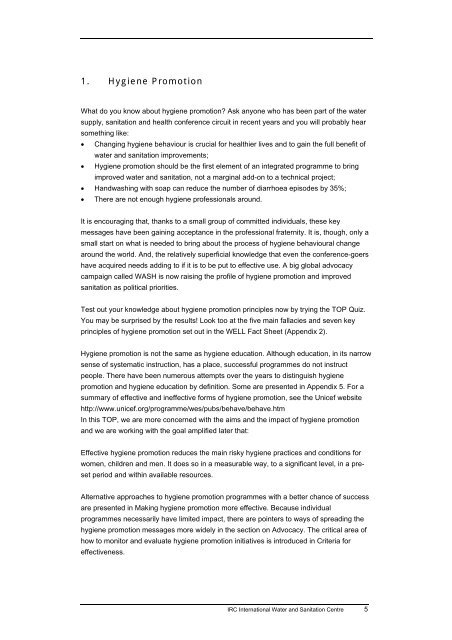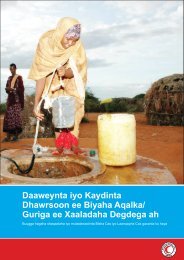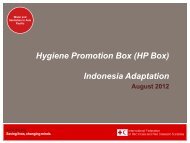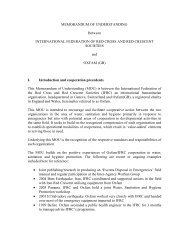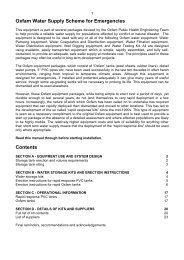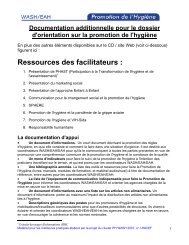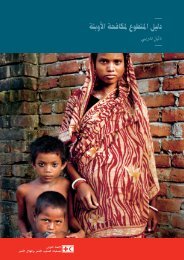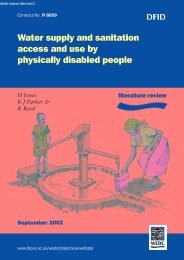Hygiene Promotion - IRC International Water and Sanitation Centre
Hygiene Promotion - IRC International Water and Sanitation Centre
Hygiene Promotion - IRC International Water and Sanitation Centre
You also want an ePaper? Increase the reach of your titles
YUMPU automatically turns print PDFs into web optimized ePapers that Google loves.
1. <strong>Hygiene</strong> <strong>Promotion</strong>What do you know about hygiene promotion? Ask anyone who has been part of the watersupply, sanitation <strong>and</strong> health conference circuit in recent years <strong>and</strong> you will probably hearsomething like:• Changing hygiene behaviour is crucial for healthier lives <strong>and</strong> to gain the full benefit ofwater <strong>and</strong> sanitation improvements;• <strong>Hygiene</strong> promotion should be the first element of an integrated programme to bringimproved water <strong>and</strong> sanitation, not a marginal add-on to a technical project;• H<strong>and</strong>washing with soap can reduce the number of diarrhoea episodes by 35%;• There are not enough hygiene professionals around.It is encouraging that, thanks to a small group of committed individuals, these keymessages have been gaining acceptance in the professional fraternity. It is, though, only asmall start on what is needed to bring about the process of hygiene behavioural changearound the world. And, the relatively superficial knowledge that even the conference-goershave acquired needs adding to if it is to be put to effective use. A big global advocacycampaign called WASH is now raising the profile of hygiene promotion <strong>and</strong> improvedsanitation as political priorities.Test out your knowledge about hygiene promotion principles now by trying the TOP Quiz.You may be surprised by the results! Look too at the five main fallacies <strong>and</strong> seven keyprinciples of hygiene promotion set out in the WELL Fact Sheet (Appendix 2).<strong>Hygiene</strong> promotion is not the same as hygiene education. Although education, in its narrowsense of systematic instruction, has a place, successful programmes do not instructpeople. There have been numerous attempts over the years to distinguish hygienepromotion <strong>and</strong> hygiene education by definition. Some are presented in Appendix 5. For asummary of effective <strong>and</strong> ineffective forms of hygiene promotion, see the Unicef websitehttp://www.unicef.org/programme/wes/pubs/behave/behave.htmIn this TOP, we are more concerned with the aims <strong>and</strong> the impact of hygiene promotion<strong>and</strong> we are working with the goal amplified later that:Effective hygiene promotion reduces the main risky hygiene practices <strong>and</strong> conditions forwomen, children <strong>and</strong> men. It does so in a measurable way, to a significant level, in a presetperiod <strong>and</strong> within available resources.Alternative approaches to hygiene promotion programmes with a better chance of successare presented in Making hygiene promotion more effective. Because individualprogrammes necessarily have limited impact, there are pointers to ways of spreading thehygiene promotion messages more widely in the section on Advocacy. The critical area ofhow to monitor <strong>and</strong> evaluate hygiene promotion initiatives is introduced in Criteria foreffectiveness.<strong>IRC</strong> <strong>International</strong> <strong>Water</strong> <strong>and</strong> <strong>Sanitation</strong> <strong>Centre</strong> 5


